
Through-The-Wall
Air Conditioner
Service Manual
CAUTION
-Before servicing the unit, read the "safety precautions" in this manual.
-Only for authorized service personnel.
HEAT CONTROLLER, INC.
MODELS: BDE-103-A
BDE-123-A

—2—
1. PREFACE
1.1 SAFETY PRECAUTIONS ...............................2
1.2 INSULATION RESISTANCE TEST.................2
1.3 FEATURES.....................................................4
1.4 CONTROL LOCATIONS.................................4
2.
DISASSEMBLY INSTRUCTIONS
2.1 MECHANICAL PARTS....................................6
2.1.1 FRONT GRILLE.....................................6
2.1.2 CABINET................................................6
2.1.3 CONTROL BOX.....................................6
2.2 AIR HANDLING PARTS..................................7
2.2.1
ORIFICE, HEATER ASSY AND TURBO FAN
.........7
2.2.2 FAN........................................................7
2.2.3 SHROUD................................................8
2.3 ELECTRICAL PARTS.....................................8
2.3.1 MOTOR..................................................8
2.3.2 COMPRESSOR.....................................8
2.3.3 CAPACITOR..........................................8
2.3.4 POWER CORD......................................9
2.3.5 THERMOSTAT ......................................9
2.3.6 ROTARY SWITCH.................................9
2.4 REFRIGERATION CYCLE............................10
2.4.1 CONDENSER......................................10
2.4.2 EVAPORATOR....................................10
2.4.3 CAPILLARY TUBE...............................10
3.
INSTALLATION
3.1 HOW TO INSTALL THE UNIT ......................13
3.2 INSTALLATION KITS CONTENTS...............14
3.3 SUGGESTED TOOL REQUIREMENTS.......15
3.3.1 PREPARATION OF SLEEVE ..............15
3.3.2 UNIT INSTALLATION..........................16
4.
TROUBLESHOOTING GUIDE
4.1 OUTSIDE DIMENSIONS...............................17
4.2 PIPING SYSTEM ..........................................17
4.3 TROUBLESHOOTING GUIDE......................18
5. SCHEMATIC DIAGRAM
5.1 CIRCUIT DIAGRAM......................................23
6. EXPLODED VIEW..................................24
7. REPLACEMENT PARTS LIST.......25
1. PREFACE
This
SERVICE MANUAL provides various service information, including the mechanical and electrical
parts etc. This room air conditioner was manufactured and assembled under a strict quality control system.
The refrigerant is charged at the factory. Be sure to read the safety precautions prior to servicing the unit.
1.1 SAFETY PRECAUTIONS
1. When servicing the unit, set the ROTARY SWITCH
or POWER SWITCH to OFF(O) and unplug the
power cord.
2. Observe the original lead dress.
If a short circuit is found, replace all parts which
have been overheated or damaged by the short
circuit.
3. After servicing the unit, make an insulation
resistance test to protect the customer from being
exposed to shock hazards.
1.2
INSULATION RESISTANCE TEST
1. Unplug the power cord and connect a jumper
between 2 pins (black and white).
2. The grounding conductor (green or green & yellow)
is to be open.
3. Measure the resistance value with an ohm meter
between the jumpered lead and each exposed
metallic part on the equipment at all the positions
(except OFF or O) of the ROTARY SWITCH.
4. The value should be over 1MΩ.
CONTENTS

—3—
1.3 SPECIFICATIONS
1.3.1 FOR BDE-103-A/BDE-123-A
REMARK
POWER SUPPLY
CAPACITY (Btu/h)
INPUT (W)
RUNNING CURRENT
(A)
E.E.R. (Btu/W.h)
CAPACITY (Btu/h)
INPUT (W)
RUNNING CURRENT
(A)
INDOOR (°C)
OUTDOOR (°C)
INDOOR (°C)
OUTDOOR (°C)
REFRIGERANT (R-22) CHARGE(g)
EVAPORATOR
CONDENSER
FAN, INDOOR
FAN, OUTDOOR
FAN SPEEDS (FAN/COOLING/HEATING)
FAN MOTOR
OPERATION CONTROL
ROOM TEMP. CONTROL
CONSTRUCTION
ELECTRIC HEATER
COMPRESSOR
FAN MOTOR
ELECTRIC HEATER
DRAIN SYSTEM
NET WEIGHT (lbs/kg)
DIMENSION (inch)
(W x H x D) (mm)
SLEEVE DIMESION (inch)
(W x H x D) (mm)
SLEEVE DEPTH (inch)
WITH FRONT GRILLE (mm)
1Ø, 208/ 230V, 60Hz
9,800/10,000 11,400/11,700
1,040/1,060 1,210/1,250
5.2/4.7 6.2/5.8
9.4 9.4
9,200/11,200
2,900/3,500
14.0/15.3
26.7 (DB) 19.4 (WB)
35 (DB) 23.9 (WB)
21.1 (DB) 15.6 (WB)
8.3 (DB) 6.1 (WB)
440(15.5 OZ) 470(16.6 OZ)
2 ROW 12 STACKS 3 ROW 12 STACKS
2 ROW 17 STACKS, L-BENDED TYPE
TURBO FAN
PROPELLER TYPE FAN WITH SLINGER-RING
1/ 2/ 2
6 POLES
ROTARY SWITCH
THERMOSTAT
VERTICAL LOUVER (RIGHT & LEFT)
HORIZONTAL LOUVER (UP & DOWN)
TOP-DOWN
3.5KW, 230V
EXTERNAL OVERLOAD PROTECTOR
INTERANL THERMAL PROTECTOR
FUSE LINK, BIMETAL THERMOSTAT
1.6m (3 WIRE WITH GROUDING)
ATTACHMENT PLUG (CORD-CONNECTED TYPE)
SPLASHED BY FAN SLINGER
80/36 81/37
24
21
/32 x 14
13
/32 x 19
21
/32
626 x 366 x 499
25
7
/8 x 15
17
/32 x 16
23
/32
656 x 394 x 425
20
510
MODELS
ITEMS
OPERATING
TEMPERA-
TURE
AIR DIRECTION CONTROL
POWER CORD
PROTECTOR
HEATING
COOLING
COOLING
HEATING
LOUVERED-
FIN TYPE
BDE-103-A BDE-123-A
OPTIONAL
PART

1.4 FEATURES
• Designed for cooling only.
• Powerful and quiet cooling.
• Top-down chassis for the simple installation and service.
1.5 CONTROL LOCATIONS
1.5.1 COOLING ONLY MODEL
• OPERATION
• VENTILATION
The ventilation lever is located in the right of the air
discharge.
The ventilation lever must be in the CLOSE position in
order to maintain the best cooling conditions.
When fresh air is necessary in the room, set the ventilation
lever to the OPEN position.
The damper is opened and room air is exhausted outside.
• ENERGY SAVER (optional)
On : Both the fan and the compressor turn on and turn off
together while operation knob is set to the Cool
position.
You can get the more economical operation.
Off : The fan runs constantly while operation knob is set to
the Cool position.
You can access the Energy Saver switch when you open
the inlet grille.
• Side air-intake, side cooled-air discharge.
• Built in adjustable THERMOSTAT.
• Washable one-touch filter.
• Compact size.
—4—
PULL OPEN / PUSH CLOSE
Off On
Energy Saver
Med
Fan
Off
Low
Fan
High
Cool
Med
Cool
Low Cool
Operation
6
7
8
9
5
1
2
3
4
Thermostat
C
o
o
l
e
r
Off - Turns air conditioner off.
Med Fan - Med speed fan operation without cooling.
Low Fan - Low speed fan operation without cooling.
High Cool - Cooling with high speed fan operation.
Med Cool - Cooling with med speed fan operation.
Low Cool - Cooling with low speed fan operation.
This automatically controls the temperature of the indoor air.
Turn the knob so that arrow points to the larger marks for
greater cooling. Point the arrow to the smaller marks for more moderate cooling.
(i.e. the higher number, the greater cooling)

1.5.2 COOLING AND HEATING MODEL
• OPERATION
—5—
A slight heat odor may come from the unit when
first switching to HEAT after the cooling season is
over. This odor, caused by fine dust particles on
the heater, will disappear quickly.
Turn the Temperature Knob to the desired setting. The central position is a normal
setting for average conditions. You can change this setting, if necessary, in
accordance with your temperature preference.
The thermostat automatically controls cooling or heating, but the fan runs
continuously whenever the air conditioner is in operation. If the room is too warm,
turn the thermostat control clockwise. If the room is too cool, turn the thermostat
control counterclockwise.
OFF - Turns the air conditioner off.
FAN ONLY - The low fan speed operation without cooling/heating.
LOW COOL - Cooling with the low speed fan operation.
HIGH COOL - Cooling with the high speed fan operation.
LOW HEAT - Heating with the low speed fan operation.
HIGH HEAT - Heating with the high speed fan operation.
When the air conditioner has been performed its cooling
or heating operation and is turned off or set to the fan
position, wait at least 3 minutes before resetting to the
cooling operation again.
CAUTION
• HEAT PUMP MODELS
When the outdoor temperature is lower than
-4°C (24°F), the electric heater will turn on instead of the
heat pump.

—6—
2.1 MECHANICAL PARTS
2.1.1 FRONT GRILLE
1. Open the inlet grille upward or downward.
2. Remove the screw which fastens the front grille.
3. Pull the front grille from the right side.
4. Remove the front grille. (See Fig. 1)
5. Re-install the component by referring to the
removal procedure.
2.1.2 CABINET
1. After disassembling the FRONT GRILLE, remove
the 9 screws which fasten the cabinet at the both
sides and the top. (See Fig. 2)
Keep these for later use.
2.1.3 CONTROL BOX
1. Remove the front grille. (Refer to section 2.1.1)
2. Remove the screw which fasten the control
box. (See Fig. 3)
3. Pull the control box from the barrier.(See Fig.3)
4. Discharge the capacitor by placing a 20,000 ohm
resistor across the capacitor terminals.
5. Disconnect two wire housings in the control box.
6. Pull the control box forward completely.
7. Re-install the components by referring to the
removal procedure. (See Fig. 3)
(Refer to the circuit diagram found on pages
26~27 in this manual and on the control box.)
2. DISASSEMBLY INSTRUCTIONS
— Before the following disassembly, POWER SWITCH is set to OFF and disconnected the power cord.
Figure 1
Figure 2
Figure 3

Figure 7
—7—
2.2 AIR HANDLING PARTS
2.2.1 ORIFICE, HEATER ASSY AND
TURBO FAN
1. Remove the front grille. (Refer to section 2.1.1)
2. Remove the cabinet. (Refer to section 2.1.2)
3. Remove the 2 screws which fasten the
evaporator at the left side and the right side.
(See Fig. 4)
4. Move the evaporator sideward carefully.
5. Remove the 2 terminals carefully
(See Fig. 5, at Electric Heater Model only)
6. Remove the 4 screws which fasten the orifice.
(See Fig. 5)
7. Remove the orifice. (See Fig. 5)
8. Remove the clamp which secures the turbo fan
with plier. (See Fig. 6)
9. Remove the turbo fan with plier or your hand
without touching blades. (See Fig. 7)
10. Re-install the components by referring to the
removal procedure, above.
2.2.2 FAN
1. Remove the cabinet. (Refer to section 2.1.2)
2. Remove the brace and shroud cover.
(Refer to section 2.2.1)
3. Remove the 6 screws which fasten the condenser.
4. Move the condenser sideways carefully.
5. Remove the clamp which secures the fan.
6. Remove the fan. (See Fig. 8)
7. Re-install the components by referring to the
removal procedure, above.
Figure 4
Figure 5
Figure 6
Figure 8

—8—
2.2.3 SHROUD
1. Remove the fan. (Refer to section 2.2.2)
2. Remove the screw which fasten the shroud.
3. Remove the shroud. (See Fig. 9)
4. Re-install the component by referring to the
removal procedure, above.
2.3 ELECTRICAL PARTS
2.3.1 MOTOR
1. Remove the cabinet. (Refer to section 2.1.2)
2. Remove the clamp cord and disconnect a wire
housing in control box. (Refer to section 2.1.3)
3. Remove the turbo fan. (Refer to section 2.2.2)
4. Remove the fan. (Refer to section 2.2.2)
5. Remove the 4 or 2 screws which fasten the motor.
(See Fig. 10)
6. Remove the motor.
7. Re-install the components by referring to the
removal procedure, above.
2.3.2 COMPRESSOR
1. Remove the cabinet. (Refer to section 2.1.2)
2. Discharge the refrigerant system using Freon
TM
Recovery System.
If there is no valve to attach the recovery system,
install one (such as a WATCO A-1) before venting
the Freon
TM
. Leave the valve in place after
servicing the system.
3. Disconnect the 3 leads from the compressor.
4. After purging the unit completely, unbraze the
suction and discharge tubes at the compressor
connections.
5. Remove the 3 nuts and the 3 washers which
fasten the compressor. (See Fig. 11)
6. Remove the compressor.
7. Re-instill the components by referring to the
removal procedure, above.
2.3.3 CAPACITOR
1. Remove the control box. (Refer to section 2.1.3)
2. Remove knobs and the tips which fasten the
display panel.
3. Disconnect the 2 leads from the rocker switch and
remove the panel (Energy saver model only).
4. Remove 2 screws and unfold the control box.
(See Fig. 12)
5. Remove the Rotary Switch.
6. Remove the screw and the clamp which fastens
the capacitor. (See Fig. 12)
7. Disconnect all the leads of capacitor terminals.
8. Re-install the components by referring to the
removal procedure, above.
Figure 9
Figure 10
Figure 11
Figure 12

—9—
2.3.4 POWER CORD
1. Remove the control box. (Refer to section 2.1.3)
2. Unfold the control box. (Refer to section 2.3.3)
3. Disconnect the grounding screw from the control
box.
4. Disconnect 2 receptacles.
5. Remove a screw which fastens the clip cord.
6. Pull the power cord. (See Fig. 13)
7. Re-install the component by referring to the
removal procedure, above.
(Use only one ground-marked hole for ground
connection.)
8. If the supply cord of this appliance is damaged, it
must be replaced by the special cord.
(The special cord means the cord which has the
same specification marked on the supply cord
fitted to the unit.)
2.3.5 THERMOSTAT
1. Remove the control box. (Refer to section 2.1.3)
2. Unfold the control box. (Refer to section 2.3.3)
3. Remove the 2 screws which fasten the thermostat.
4. Disconnect all the leads of thermostat terminals.
5. Remove the thermostat. (See Fig. 14)
6. Re-install the components by referring to the
removal procedure, above.
2.3.6 ROTARY SWITCH
1. Remove the control box. (Refer to section 2.1.3)
2. Unfold the control box. (Refer to section 2.3.3)
3. Remove 2 screws which fasten the rotary switch.
4. Disconnect all the leads of the rotary switch
terminals.
5. Remove the rotary switch. (See Fig. 15)
6. Re-install the components by referring to the
above removal procedure, above.
Figure 13
Figure 14
Figure 15

—10—
2.4 REFRIGERATION CYCLE
2.4.1 CONDENSER
1. Remove the cabinet. (Refer to section 2.1.2)
2. Remove the brace and the shroud cover.
(Refer to section 2.2.1)
3. Remove the 5 screws which fasten the condenser.
4. After discharging the refrigerant completely,
unbraze the interconnecting tube at the condenser
connections.
5. Remove the condenser.
6. Re-install the components by referring to notes.
(See Fig. 16)
2.4.2 EVAPORATOR
1. Remove the cabinet. (Refer to section 2.1.2)
2. Discharge the refrigerant completely.
3. Remove the 2 screws which fasten the evaporator
at the left side and the right side.
4. Move the evaporator sideward carefully and then
unbraze the interconnecting tube at the evaporator
connectors.
5. Remove the evaporator.
6. Re-install the components by referring to notes.
(See Fig. 17)
2.4.3 CAPILLARY TUBE
1. Remove the cabinet. (Refer to section 2.1.2)
2. After discharging the refrigerant completely,
unbraze the interconnecting tube at the capillary
tube.
3. Remove the capillary tube.
4. Re-install the components by referring to notes.
Figure 16
Figure 17
Discharge the refrigerant system using Freon
TM
Recovery System.
If there is no valve to attach the recovery system,
install one (such as a WATCO A-1) before
venting the Freon
TM
. Leave the valve in place
after servicing the system.
CAUTION

—11—
— Replacement of the refrigeration cycle.
1. When replacing the refrigeration cycle, be sure to
discharge the refrigerant system using a Freon
TM
recovery System.
If there is no valve to attach the recovery system,
install one (such as a WATCO A-1) before venting
the Freon
TM
. Leave the valve in place after
servicing the system.
2. After discharging the unit completely, remove the
desired component, and unbrace the pinch-off
tubes.
3. Solder service valves into the pinch-off tube ports,
leaving the valves open.
4. Solder the pinch-off tubes with Service valves.
5. Evacuate as follows.
1) Connect the vacuum pump, as illustrated Fig.
18A.
2) Start the vacuum pump, slowly open manifold
valves A and B with two full turns
counterclockwise and leave the valves closed.
The vacuum pump is now pulling through valves
A and B up to valve C by means of the manifold
and entire system.
3) Operate the vacuum pump for 20 to 30 minutes,
until 600 microns of vacuum is obtained. Close
valves A and B, and observe vacuum gauge for
a few minutes. A rise in pressure would
indicate a possible leak or moisture remaining in
the system. With valves A and B closed, stop
the vacuum pump.
4) Remove the hose from the vacuum pump and
place it on the charging cylinder. See Fig. 18B.
Open valve C.
Discharge the line at the manifold connection.
5) The system is now ready for final charging.
6. Recharge as follows :
1) Refrigeration cycle systems are charged from the
High-side. If the total charge cannot be put
in the High-side, the balance will be put in the
suction line through the access valve which you
installed as the system was opened.
2)
Connect the charging cylinder as shown in Fig. 18B.
With valve C open, discharge the hose at the
manifold connection.
3) Open valve A and allow the proper charge to
enter the system. Valve B is still closed.
4) If more charge is required, the high-side will not
take it. Close valve A.
5) With the unit running, open valve B and add the
balance of the charge.
a. Do not add the liquid refrigerant to the Low-
side.
b. Watch the Low-side gauge; allow pressure to
rise to 30 lbs.
c. Turn off valve B and allow pressure to drop.
d. Repeat steps B and C until the balance of the
charge is in the system.
6) When satisfied the unit is operating correctly,
use the pinch-off tool with the unit still running
and clamp on to the pinch-off tube. Using a tube
cutter, cut the pinch-off tube about 2 inches from
the pinch-off tool. Use sil-fos solder and solder
pinch-off tube closed. Turn off the unit, allow it to
set for a while, and then test the leakage of the
pinch-off connection.
NOTES
If high vacuum equipment is used, just crack
valves A and B for a few minutes, then open
slowly with the two full turns counterclockwise.
This will keep oil from foaming and being
drawn into the vacuum pump.
CAUTION

—12—
Equipment needed: Vacuum pump, Charging cylinder, Manifold gauge, Brazing equipment. Pinch-off tool
capable of making a vapor-proof seal, Leak detector, Tubing cutter, Hand Tools to remove components, Service
valve.
A
COMPOUND GAUGE
EVAPORATOR
(LOW PRESSURE SIDE)
COMPRESSOR
CAPILLARY TUBE
CONDENSER
(HIGH PRESSURE SIDE)
SEE INSETS
BELOW
MANIFOLD
GAUGE
B
Figure 18A-Pulling Vacuum
Figure 18B-Charging
A
B
EXTERNAL
VACUUM PUMP
A
CHARGING
CYLINDER
LOW
HI
B
C

—13—
3. INSTALLATION
3.1 HOW TO INSTALL THE UNIT
For existing sleeve, you should measure the wall sleeve
dimensions.
You can install the new air conditioner according to these
installation instructions to achieve the best performence. All
wall sleeves used to mount the new air conditioner must be in
good structural condition and have the rear grille that securely
attaches to the sleeve or the flange of the sleeve to secure the
new air conditioner.
• To avoid vibration and noise, make sure the unit is installed
securely and firmly.
A. BEFORE ATTACHING THE FRONT
GRILLE TO THE CABINET, IF YOU WANT
TO PULL OUT THE FILTER UPWARD;
1. There should be no obstacle, like a fence, within 20" which
might restrict heat radiation from the condenser.
2. To prevent reducing performance, install the unit so that
louvers of the cabinet are not blocked.
B. IF YOU WANT TO PULL OUT THE FILTER
DOWNWARD;
The grille is already designed for that way.
1. Install the unit a little obliquely outward not to leak the
condensed water into the room (about 1/2" or 1/4" bubble
with level).
2. Install the unit with its bottom portion 30~60" above the floor
level.
3. The power cord must be connected to an independent
circuit. The green wire must be grounded.
14-
13
/32"
(366 mm)
24-
21
/32"
(626 mm)
18"(458 mm)
19-
21
/32"
(499 mm)
15-
17
/32"
(394 mm)
25-
7
/8"
(656 mm)
16-
23
/32"
(425 mm)
Over 20"
HEAT
RADIATION
WALL
WALL
INSULATION SLEEVE
INTAKE
AIR
COOLED
AIR
Level
1/4" Bubble
1/4" Bubble
of the level
• There are sharp edges that can cause serious cuts.
• When lifting the air conditioner, it is HEAVY.
Use 2 peoples to lift.
CAUTION
Dimension of air conditioner
Dimension of sleeve assembly (optional)

—14—
3.2 INSTALLATION KITS CONTENTS
Air Conditioner
1
2
Sleeve Assembly
(optional, including expanded
aluminum metal grille)
1 Insulation Front (1 ea)
3 Insulation Vertical (4 ea)
(Adhesive backed)
4 Support Block (4 ea)
(Adhesive backed)
5 Baffle (2 ea)
(Plastic sheet)
2 Insulation Horizontal (2 ea)
(Adhesive backed)
Louvered Grille
(optional)
Trim (2 ea)
4
5
3
14"
(355 mm)
82-
11
/16"
(2,100 mm)
26-
3
/8"
(670 mm)

—15—
3.3.1 PREPARATION OF SLEEVE
1. Remove the old air conditioner from the wall sleeve and
prepare the wall sleeve.
Clean the interior of the sleeve (do not disturb the insulation
or seals).
The wall sleeve must be fastened in the wall securely before
installing the new air conditioner.
2. Prepare the wall sleeve for installation of the new unit
according to the following installation procedures. Before
you prepare the wall sleeve, you should check the wall
sleeve dimensions.
3. Redirect the louvers at the back of the wall sleeves as
following A and B lengths in the below table.
4. Sleeve (up to 18 inches deep)
When the depth of your existing sleeve is deeper than 18",
please skip to step 5.
Remove the backing from horizontal insulation and attach
them to the inside of the wall sleeve as shown below.
Remove the backing from insulation vertical and attach them
to the inside of the wall sleeve, as shown below.
5. Sleeve (18~22 inches deep)
When the depth of your existing sleeve is not deeper than
18", please skip to step 6.
Cut the baffles and the support blocks as following C length
in the below table.
SCREWDRIVER(+, -), RULER, KNIFE, HAMMER, PENCIL, LEVEL
Wall
Wall Sleeve
Front
Insulation
Horizontal
(2 ea)
1
/2"
(12 mm)
1-
1
/4"
(32 mm)
45~60°
45~60° 45~60°
Top view of the wall sleeveWall Wall
AB
B
4-
3
/
4
"(120 mm)
5" (130 mm)
5" (130 mm)
5-
1
/
2
"(140 mm)
5-
1
/
2
"(140 mm)
A
2-
3
/
4
" (70 mm)
2-
3
/
4
" (70 mm)
3" (75 mm)
3-
1
/
4
" (80 mm)
3-
1
/
2
" (90 mm)
Width of the existing
wall sleeve
25-
1
/
2
"(648 mm)
25-
3
/
4
"(654 mm)
26" (660 mm)
26-
3
/
4
"(680 mm)
27" (686 mm)
Wall
Wall Sleeve
A
B
Front
Support
Block
Baffle
C
C
Depth of the existing
wall sleeve
C
18-
5
/
8
" (473 mm)
3
/
4
" (20 mm)
19-
3
/
4
" (502 mm) 1-
3
/
4
" (45 mm)
22" (559 mm) 4"
(100 mm)
3.3 SUGGESTED TOOL REQUIREMENTS

—16—
Remove the backing from vertical and horizontal insulation and
attach them to the inside of the wall sleeve as shown below.
Remove the backing from the support blocks and attach them
to the inside of the wall sleeve as shown below. Slide the
baffles in the slots of the support blocks.
3.3.2 UNIT INSTALLATION
1. Remove the backing from vertical insulation and attach them
to the back of the unit as shown below.
2. Install the new unit into the wall sleeve.
3. Insert front insulation between the wall sleeve and the unit.
A flat-bladed screwdriver or putty knife is recommended.
4. To assemble trim, insert the snaps into the slots of others.
To install trim to the sleeve, slide the trim through the unit
until it is flush with the wall sleeve.
Wall
Trim (2 ea)
Wall
Wall Sleeve
Vertical
Insulation
Front
A
B
Wall
Wall
Sleeve
Insulation
Horizontal
A+
1
/4"
(6 mm)
B+
1
/4"
(6 mm)
Insulation
Vertical
Front

—17—
4. TROUBLESHOOTING GUIDE
4.1 OUTSIDE DIMENSIONS
19-
21
/32"
(499mm)
24-
21
/32"
(626mm)
14-
13
/32"
(366mm)
CONDENSER COILS
EVAPORATOR COILS
FAN
MOTOR
: REFRIGERANT FLOW
TURBO FAN
CAPILLARY TUBE
COMPRESSOR
4.2 PIPING SYSTEM
Following is a brief description of the important components and their functions in the refrigeration system.
Refer to Fig. 19 to follow the refrigeration cycle and the flow of the refrigerant in the cooling cycle.
MOTOR
COMPRESSOR
OIL
(LIQUID REFRIGERANT)
CAPILLARY TUBE
OUTSIDE COOLING
AIR FOR REFRIGERANT
PASS THROUGH
SUCTION LIME
COOL LOW PRESSURE VAPOR
COOLED
AIR
COMPLETE LIQUID
BOIL OFF POINT
LIQUID
PRESSURE
DROP
ROOM AIR HEAT LOAD
VAPOR INLET
HOT
DISCHARGED
AIR
LIQUID OUTLET
HIGH PRESSURE VAPOR
LIQUID PEFRIGERANT
LOW PRESSURE VAPOR
ROOM AIR CONDITIONER
EVAPORATOR COILS CONDENSER COILS
CYCLE OF REFRIGERATION
Figure 19

—18—
4.3 TROUBLESHOOTING GUIDE
In general, possible trouble is classified in two causes.
The one is called Starting Failure which is caused from an electrical defect, and the other is Ineffective Air
Conditioning caused by a defect in the refrigeration circuit and improper application.
Unit is running but cooling is ineffective
Ineffective Cooling
Check of outdoor coil
(heat exchanger) & the fan
operation.
Check gas leakage.
Repair gas leak.
Replacement of unit if the
unit is beyond repair.
Satisfactory operation with
temperature difference of
inlet & outlet air ; 44.6~50˚F
Check heat load increase.
Unexpected residue
Overloaded Circuit
Check of inside gas
pressure.
Adjusting of refrigerant
charge
Malfunction of compressor
Replacement of
compressor
Check of cold air circulation
for smooth flow.
Dirty indoor coil
(Heat exchanger)
Malfunction of fan
Clogged of air filter
Obstruction at air outlet
Correct above trouble
Stop of auto air-swing
Check clogging in
refrigeration circuit.
Repair clogging in
refrigeration circuit.

—19—
Fails to Start
Check of circuit breaker
and fuse.
Gas leakage of feeler bulb
of thermostat
Check of control switch.
Only fan fails to start.
Improper wiring.
Defect of fan motor
capacitor.
Irregular motor resistance
( ).
Irregular motor insulation
( ).
Replacement of fan motor
Regular but fails to start
Replacement of compressor
(locking of rotor, metal)
Improper thermostat setting
Loose terminal connection.
Improper wiring
Irregular motor resistance ( )
Irregular motor insulation ( )
Replacement of compressor
(Motor damaged)
Drop of power voltage.
Check capacitor.
Replacement.
Only compressor fails to
start.
Defect of compressor
capacitor.
Check of power source.
Check of control switch
setting.

—20——20—
COMPLAINT CAUSE REMEDY
Check voltage at outlet. Correct if none.
Check voltage to rotary switch. If none, check
power supply cord. Replace cord if circuit is open.
Check switch continuity. Refer to wiring diagram
for terminal identification. Replace switch if
defective.
Connect wire. Refer to wiring diagram for terminal
identification. Repair or replace loose terminal.
Test capacitor.
Replace if not within ±10% of manufacturer's
rating. Replace if shorted, open, or damaged.
Fan blade hitting shroud or blower wheel hitting
scroll. Realign assembly.
Units using slinger ring condenser fans must
have
1
/
4
to
5
/
16
inch clearance to the base. If it is
hitting the base, shim up the bottom of the fan
motor with mounting screw(s).
Check fan motor bearings; if motor shaft will not
rotate, replace the motor.
Check voltage. See limits on this page. If not within
limits, call an electrician.
Test capacitor.
Check bearings. Does the fan blade rotate freely?
If not, replace fan motor.
Pay attention to any change from high speed to
low speed. If the speed does not change, replace
the motor.
Check grommets; if worn or missing, replace them.
If cracked, out of balance, or partially missing,
replace it.
If cracked, out of balance, or partially missing,
replace it.
Tighten it.
If knocking sounds continue when running or
loose, replace the motor. If the motor hums or
noise appears to be internal while running,
replace motor.
No power
Power supply cord
Rotary switch
Wire disconnected or
connection loose
Capacitor (Discharge
capacitor before testing.)
Will not rotate
Revolves on overload.
Grommets
Fan
Turbo fan
Loose set screw
Worn bearings
Fan motor will not run.
Fan motor runs
intermittently
Fan motor noise.
Page is loading ...
Page is loading ...
Page is loading ...
Page is loading ...
Page is loading ...
Page is loading ...
-
 1
1
-
 2
2
-
 3
3
-
 4
4
-
 5
5
-
 6
6
-
 7
7
-
 8
8
-
 9
9
-
 10
10
-
 11
11
-
 12
12
-
 13
13
-
 14
14
-
 15
15
-
 16
16
-
 17
17
-
 18
18
-
 19
19
-
 20
20
-
 21
21
-
 22
22
-
 23
23
-
 24
24
-
 25
25
-
 26
26
Heat Controller Room Air Thru-the-Wall Series BDE-103A BDE-123A User manual
- Type
- User manual
- This manual is also suitable for
Ask a question and I''ll find the answer in the document
Finding information in a document is now easier with AI
Related papers
-
Heat Controller BD-81 User manual
-
COMFORT-AIRE LT0810CR User manual
-
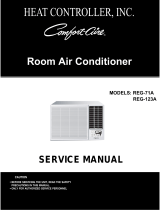 Heat Controller Comfort-Aire REG-123A User manual
Heat Controller Comfort-Aire REG-123A User manual
-
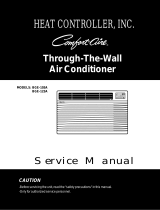 Heat Controller Comfort-Aire BGE-123A User manual
Heat Controller Comfort-Aire BGE-123A User manual
-
COMFORT-AIRE Comfort-Aire CD-101-5 User manual
-
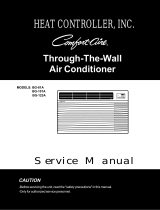 Heat Controller BG-81A User manual
Heat Controller BG-81A User manual
-
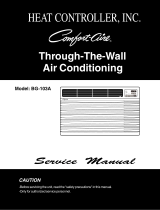 Heat Controller BG-103A User manual
Heat Controller BG-103A User manual
-
COMFORT-AIRE SMH18 User manual
Other documents
-
Friedrich ZQ05B10 User manual
-
LG LWJ0561ACG User manual
-
Hotpoint LT143CNR User manual
-
Friedrich CP05A10 User manual
-
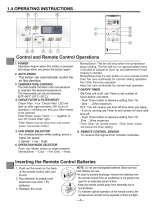 Friedrich Air Conditioning EP12G33 User guide
Friedrich Air Conditioning EP12G33 User guide
-
Friedrich US10A30A Owner's manual
-
Friedrich US12B10 Owner's manual
-
Friedrich UE12A33B Owner's manual
-
LG CHECK Owner's manual
-
Goldstar M2404HR Owner's manual






























